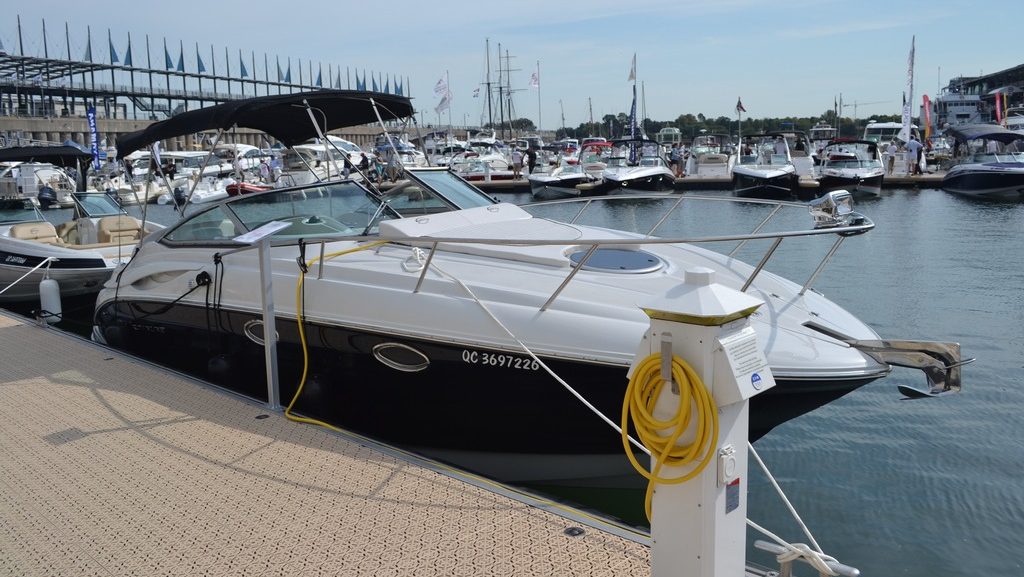In a previous article about how corrosion affects the submerged parts of pleasure craft, we presented galvanic corrosion as a “natural” phenomenon that occurs when two dissimilar metals come in contact with each other (electrical continuity) in a conductive medium (electrolyte). A direct electrical current is created, causing matter to be displaced. The less noble metal (more electronegative, according to the galvanic corrosion chart) becomes an anode and dissolves itself in lieu of the more noble metal (relatively less electronegative), which has now become cathodic.
For instance, a boat’s aluminum alloy sterndrive could be connected to a stainless steel propeller. Unprotected, the metal in the sterndrive dissolves in lieu of the stainless steel and, in the long run, corrosion causes significant and costly damages, especially around the edges of the sterndrive. To ensure the integrity of submerged parts, anodes that will “sacrifice” themselves in lieu of the parts to be protected must be inserted into the circuit bonding the submerged metal parts. This is why it is important to check the condition of the protective anodes (zinc or aluminum in salt or fresh water, magnesium in fresh water only) on a regular basis. In general, anodes are replaced in winter, when it is easier to spot wear and tear and determine anode efficiency. Nonetheless, more vigilance is required when verifying the anodes if you’re dealing with certain types of corrosion, for example, electrolytic corrosion.
Cruiser hooked up to a dock and the effects of electrolytic corrosion
Beyond the natural phenomenon, another form of corrosion is the oftentimes accidental electrolytic corrosion. This type of galvanic corrosion represents a real risk for cruisers when they are hooked up to a dock and equipped with several electrical systems and equipment.
Electrolytic corrosion is frequently caused by current leaking from the direct current system. Thus, a faulty electrical accessory, defective cable, or an improperly plugged wire could cause stray and uncontrolled currents to leak from the boat and speed up the consumption rate of sacrificial anodes. The current leakages can quickly reach important submerged parts such as sterndrives, propellers, shafts, and stabilizers. This type of corrosion is much more harmful and aggressive, and can rapidly cause severe damages to your boat.
It is therefore important to check each equipment’s circuit to ensure that no current is leaking outside of the ground bonding system. These leaks are often caused by an electronic accessory such as a VHF radio antenna, a defective automatic bilge pump or a battery charger that does not comply with marine specifications, among other things.
For additional protection, some pleasure craft are equipped with anodes that emit reverse blocking current to stop underwater electrical activity from causing electrolytic corrosion. Mercury Marine’s Mercathode system is an example of this type of cathodic protection.
The presence of alternating current (110 V) outside the boat can also result in this type of corrosion, whether from shore power hookups or electrically interconnected boats leaking current into the water. This electrical activity is often difficult to determine, but its effects are just as devastating as those from direct current leaks. Despite the fact that some pleasure craft are protected by a galvanic insulator, always verify the electric potential of your boat’s hull if sacrificial anodes are being consumed too quickly.
Finally, the limited warranty offered by most engine (and sterndrive) manufacturers generally does not cover the harmful effects of this type of accidental corrosion.
Conclusion
Electrolytic corrosion is a type of galvanic corrosion that occurs when the submerged metal parts of a boat are exposed to abnormal electric current stemming from direct or alternating current leakage. Sacrificial anodes, which come in various sizes and serve different purposes, remain the most efficient way to protect against this aggressive type of galvanic corrosion. Regular checking and management of sacrificial anodes will enable you to maintain the integrity of your boat’s submerged metal parts.

